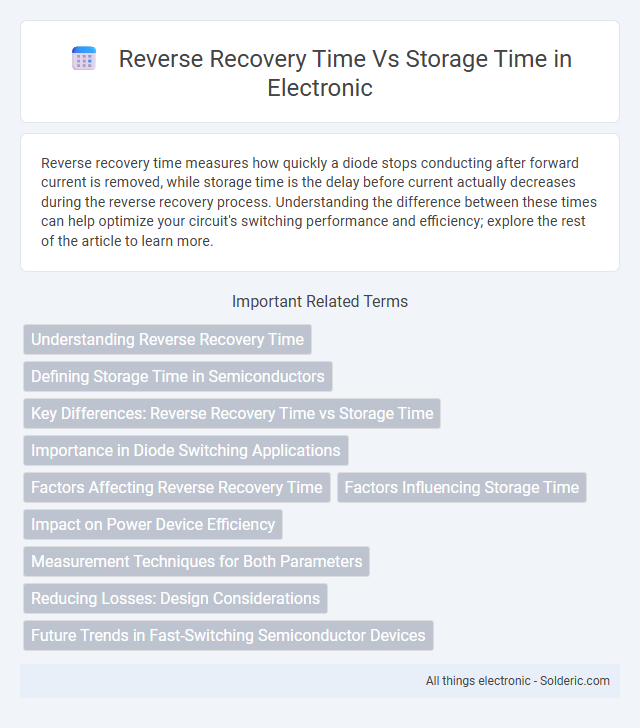Reverse recovery time measures how quickly a diode stops conducting after forward current is removed, while storage time is the delay before current actually decreases during the reverse recovery process. Understanding the difference between these times can help optimize your circuit's switching performance and efficiency; explore the rest of the article to learn more.
Comparison Table
| Parameter | Reverse Recovery Time (trr) | Storage Time (ts) |
|---|---|---|
| Definition | Time taken for a diode to switch from conducting in reverse direction to blocking state | Duration charge carriers remain stored in the junction before recombination |
| Context | Important in switching diodes and rectifiers to prevent reverse current spikes | Relevant in bipolar transistors and diodes affecting switching speed |
| Measurement | Measured from zero crossing of reverse current until it decays to zero | Measured as the initial portion of the reverse recovery period where stored charge dissipates |
| Impact | Directly influences switching losses and efficiency in power electronics | Impacts turn-off delay and switching speed in semiconductor devices |
| Typical value range | Nanoseconds (ns) to microseconds (us), depending on the device type | Often constitutes a major part of the reverse recovery time |
Understanding Reverse Recovery Time
Reverse recovery time is the interval during which a diode transitions from conducting in the forward direction to blocking in the reverse direction, impacting switching performance in power electronics. Storage time, a component of reverse recovery time, refers to the duration carriers remain stored in the junction before reverse current decreases. Understanding reverse recovery time helps optimize your circuit's efficiency by minimizing switching losses and electromagnetic interference.
Defining Storage Time in Semiconductors
Storage time in semiconductors refers to the duration during which excess minority carriers remain stored in the device after the forward current is switched off, directly influencing the diode's turn-off behavior. It plays a critical role in determining the total reverse recovery time, which encompasses both storage time and the fall time of reverse current. Optimizing storage time is essential for high-speed switching applications to reduce power loss and improve efficiency.
Key Differences: Reverse Recovery Time vs Storage Time
Reverse recovery time measures the duration for a diode to switch from conducting to blocking state after forward current is removed, directly impacting switching speed and efficiency in high-frequency circuits. Storage time refers to the interval during which excess minority carriers are stored in the diode before recombination begins, influencing the delay before voltage recovery. The key difference lies in reverse recovery time encompassing the total transition to blocking mode, while storage time specifically accounts for carrier recombination delay within the diode.
Importance in Diode Switching Applications
Reverse recovery time significantly impacts diode switching performance by determining how quickly the diode ceases conduction after forward current is removed, directly affecting switching losses and efficiency. Storage time, the interval during which minority carriers remain stored in the diode before reverse recovery begins, influences the delay in transition from forward to reverse bias. Understanding and optimizing both parameters ensures your diode operates efficiently in high-speed switching applications, reducing power dissipation and enhancing overall circuit reliability.
Factors Affecting Reverse Recovery Time
Reverse recovery time in diodes is influenced primarily by the doping concentration and the carrier lifetime within the semiconductor material. Higher doping levels reduce the charge storage, thereby shortening both reverse recovery and storage times, while longer carrier lifetimes increase the amount of charge that must be removed. Device temperature and current rate also significantly affect reverse recovery time, with elevated temperatures and faster current changes typically leading to shorter recovery durations.
Factors Influencing Storage Time
Storage time in diodes is primarily influenced by excess minority carrier charge that must be removed before the device can switch off, which is directly affected by junction temperature and current levels. Higher forward current densities increase storage time due to larger charge storage, while elevated temperatures accelerate recombination, reducing it. Understanding these factors helps you predict diode behavior during switching and optimize circuit performance.
Impact on Power Device Efficiency
Reverse recovery time directly affects switching losses in power devices, as prolonged recovery intervals increase energy dissipation during turn-off events. Storage time, a component of reverse recovery, contributes to delayed transistor response and elevated conduction losses, reducing overall efficiency. Minimizing both parameters through advanced device design enhances switching performance and optimizes power device efficiency in high-frequency applications.
Measurement Techniques for Both Parameters
Reverse recovery time is measured using double-pulse testing methods where a diode is switched from forward to reverse bias, capturing the transient current decay with an oscilloscope. Storage time measurement involves analyzing the interval during which the diode holds minority carriers, commonly detected via time-domain reflectometry or gated oscilloscopes to observe the current tail. Both parameters require precise timing instruments and waveform analysis to ensure accurate characterization of diode switching performance.
Reducing Losses: Design Considerations
Reducing losses in reverse recovery time and storage time requires optimizing diode design parameters such as doping levels and junction geometry to minimize stored charge. Incorporating fast recovery diodes with low junction capacitance and utilizing semiconductor materials like SiC or GaN enhances switching performance and reduces energy dissipation. Careful balance between minimizing reverse recovery current and storage charge effectively lowers switching losses and improves overall conversion efficiency in power electronics.
Future Trends in Fast-Switching Semiconductor Devices
Future trends in fast-switching semiconductor devices emphasize reducing reverse recovery time and storage time to enhance efficiency and minimize switching losses in power electronics. Innovations in wide-bandgap materials like silicon carbide (SiC) and gallium nitride (GaN) enable faster carrier recombination, significantly decreasing reverse recovery-related energy dissipation. Emerging device architectures such as trench MOSFETs and superjunction diodes optimize charge storage dynamics, crucial for high-frequency applications in electric vehicles and renewable energy systems.
Reverse recovery time vs storage time Infographic

 solderic.com
solderic.com